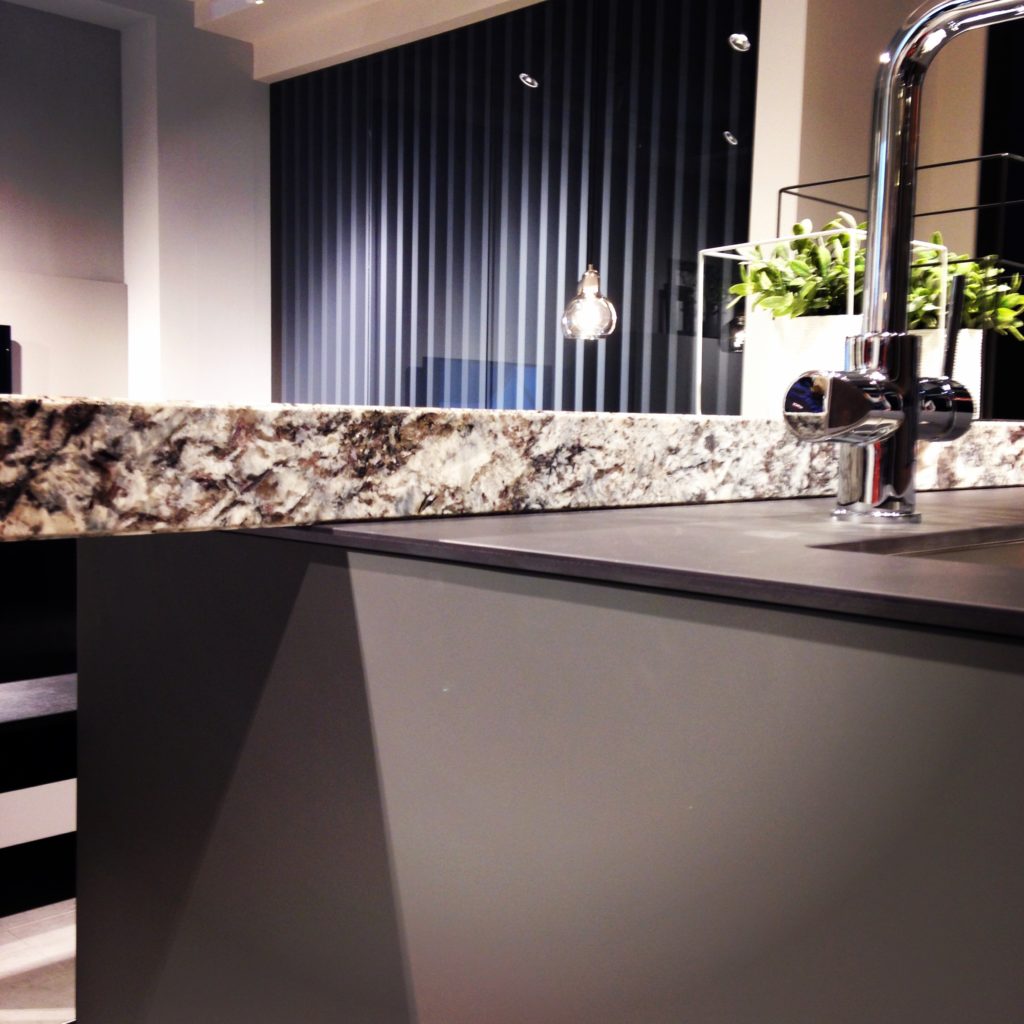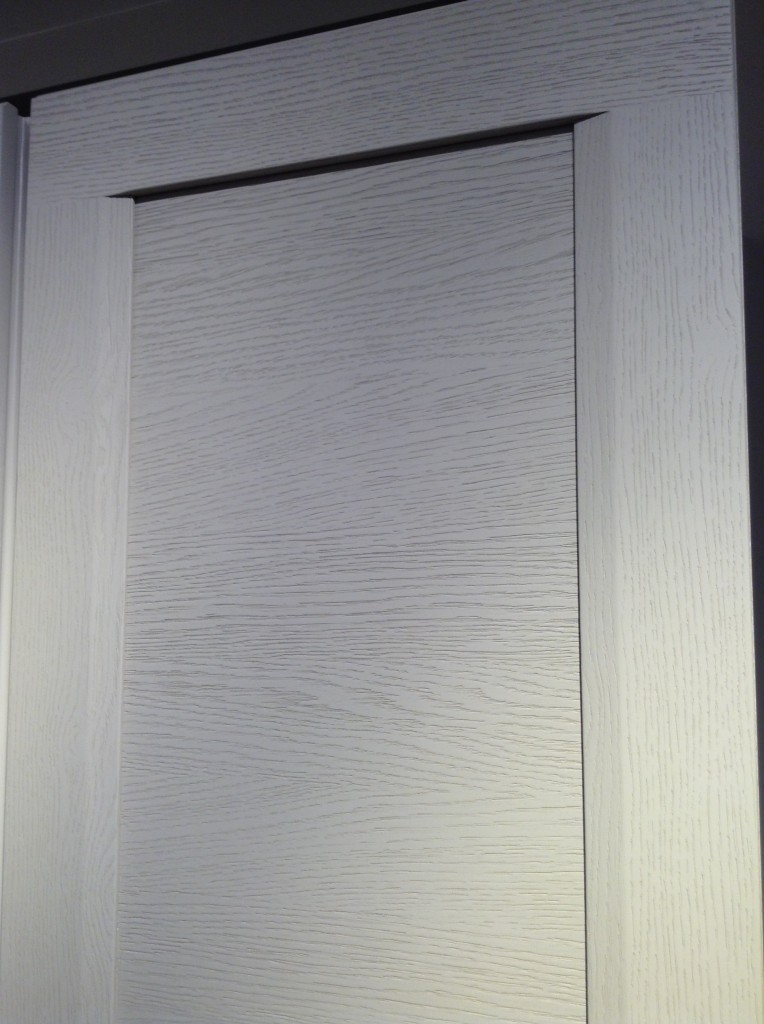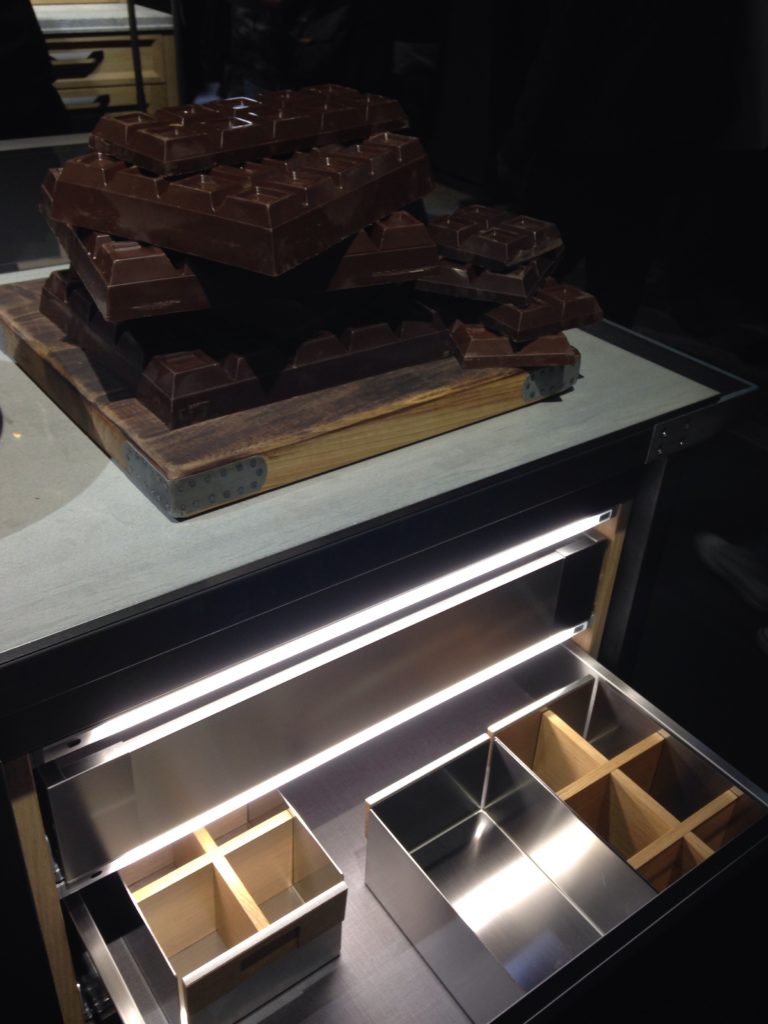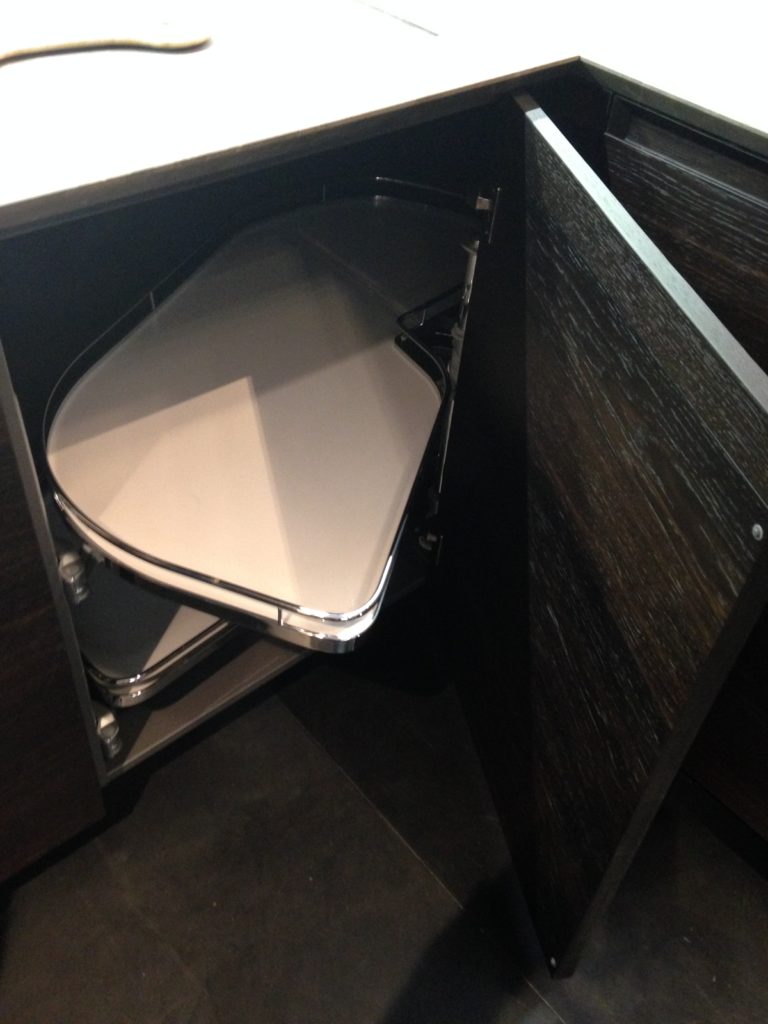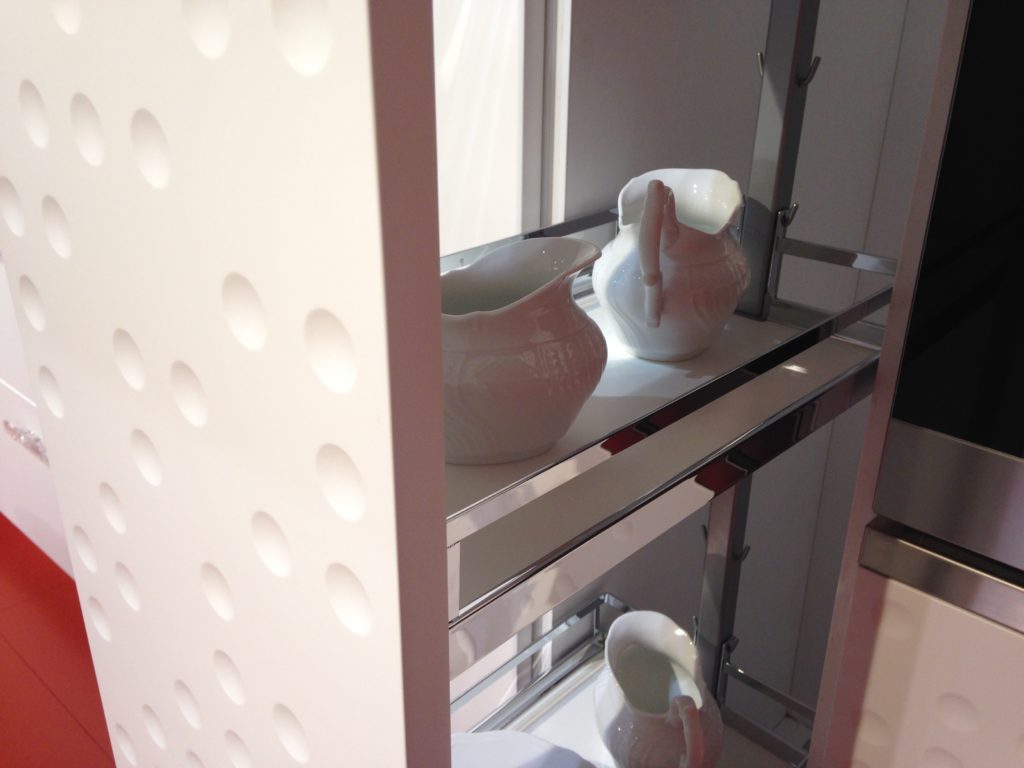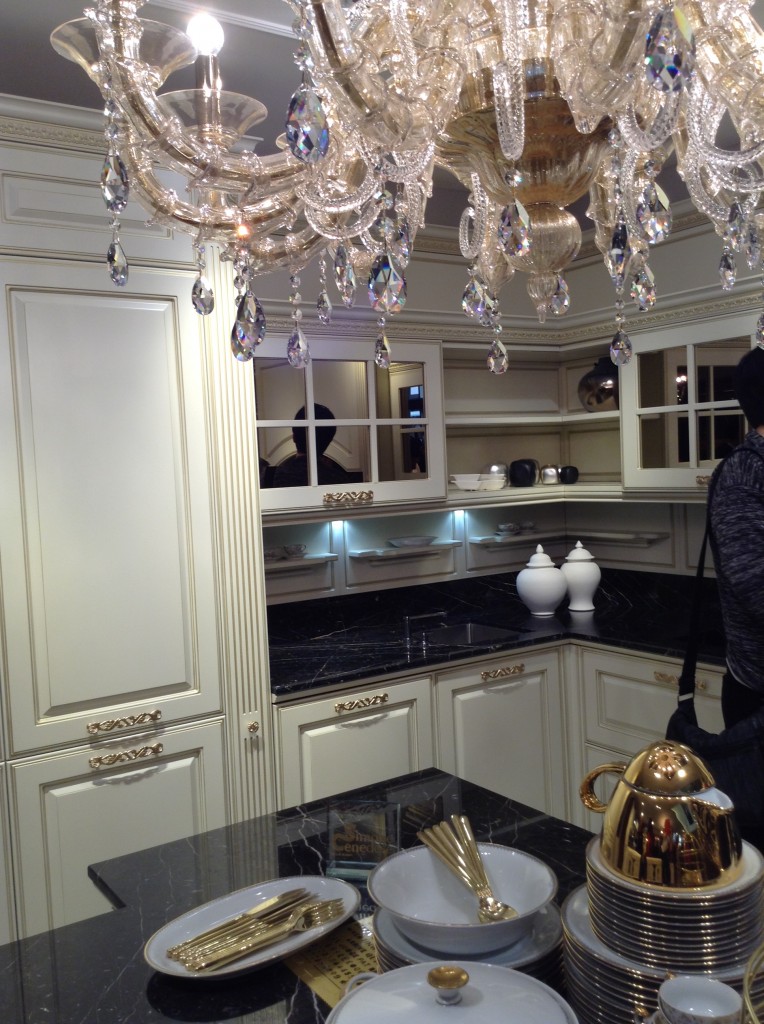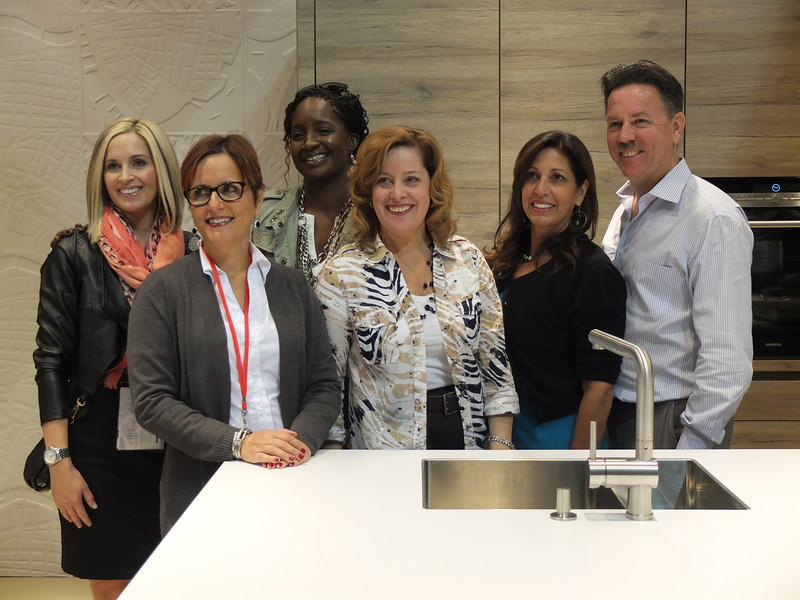When did I visit Milan again? Oh yeah, April 2014. Time flies. You see the thing is, when you go to these sensory overloading mind boggling trade shows you bring it all home with you in the form of dvds, thumb drives, brochures, samples etc.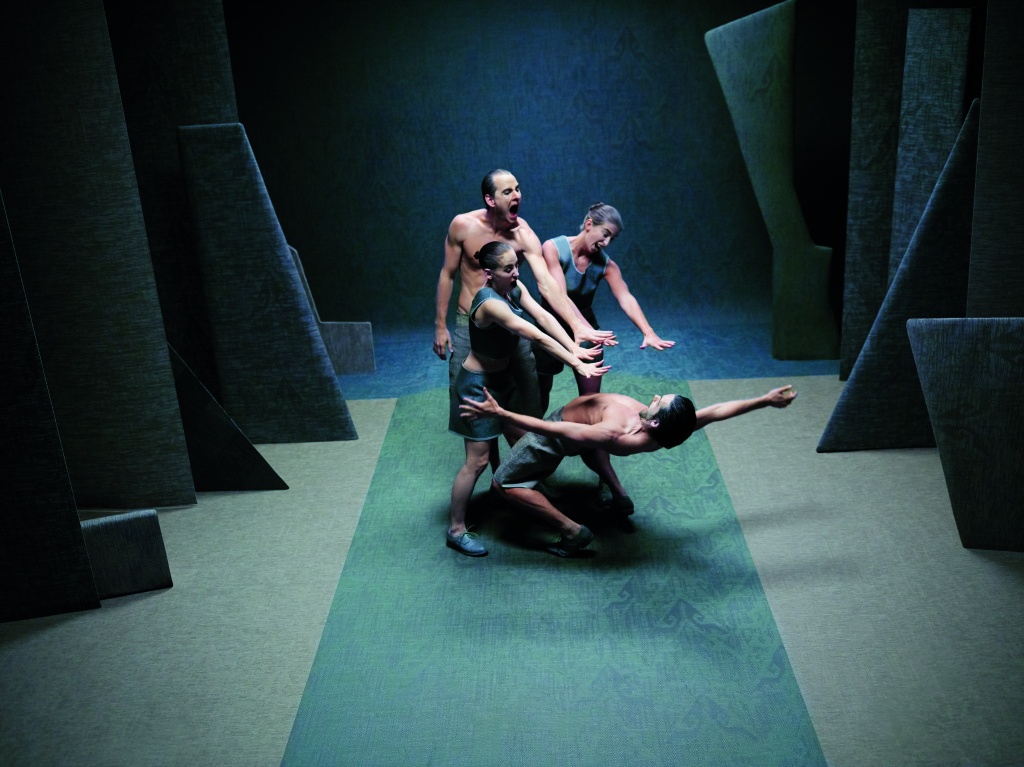 The problem is when you get home it’s so busy all these bits end up sitting in a "some day" drawer. Well guess what? Today’s the day.
The problem is when you get home it’s so busy all these bits end up sitting in a "some day" drawer. Well guess what? Today’s the day. Back to Milan. I was there as a member of the Blanco Design Council (a fact that I am most proud of and grateful for) to attend the Salone di Mobile, the premiere European interior design and furniture trade show. Fast forward to today when I decided to fire up a thumb drive called Bolon. Let me tell you about it.
Back to Milan. I was there as a member of the Blanco Design Council (a fact that I am most proud of and grateful for) to attend the Salone di Mobile, the premiere European interior design and furniture trade show. Fast forward to today when I decided to fire up a thumb drive called Bolon. Let me tell you about it.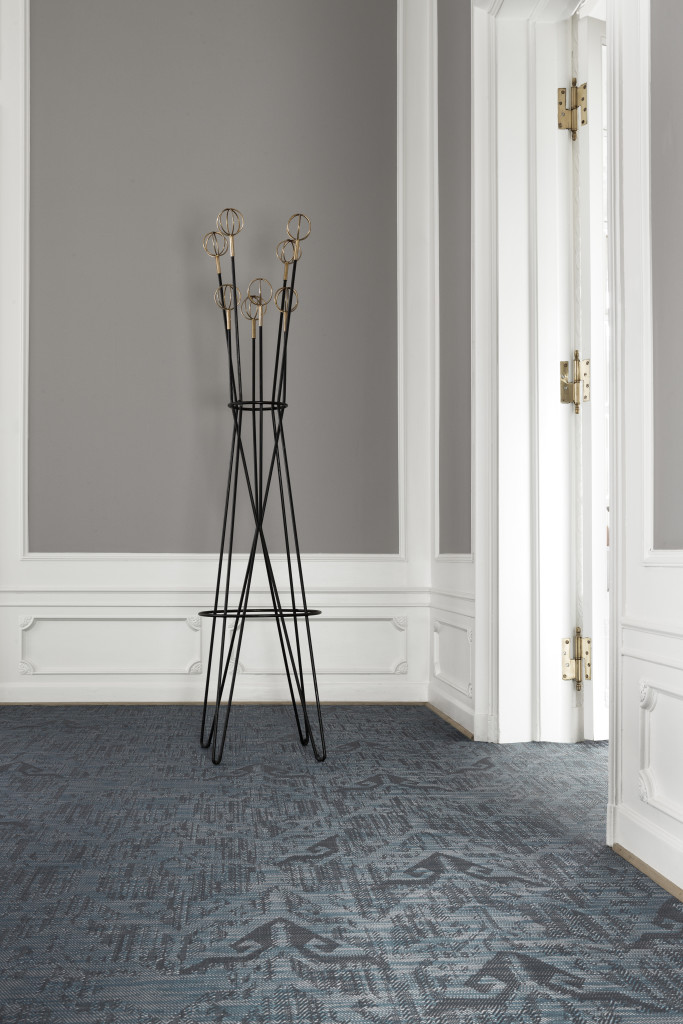 Bolon is a Swedish flooring manufacturer but there is so much more to it! The concept of fashion has a way of elevating even the most mundane of objects. That’s what’s so intriguing about Bolon, started in Stockholm in 1949 by Nils-Erik Eklund. He became a pioneer of the “green” movement when he decided he would make woven rag rug flooring from the waste product of other flooring manufacturers. The business succeeded, was passed on and has been run by his granddaughters Annica and Marie Eklund since 2003. That’s when fashion entered the picture. The term “floored by fashion” was coined and fashion icon Giorgio Armani decided he loved the product enough to use it in his shops, his home and on his yacht. Savvy marketing by this latest generation of Eklands seals the deal. You must admit this video, introducing their Silence line, is intriguing enough to make you want to know what this product is all about!It’s an original type of flooring that I would describe as woven vinyl with a backing. It can look natural or not, doesn’t seem particularly comfy on the bare foot but does appear to be bullet-proof, a definite plus for commercial spaces which is the main application.Today the focus is on global expansion and achieving a totally green product. Bolon’s list of clients includes not only Armani but also Google, Mercedes, Adidas, Reebok and Sheraton as well as leading architects and designers. All design and production happens in Ulricehamn, Sweden.
Bolon is a Swedish flooring manufacturer but there is so much more to it! The concept of fashion has a way of elevating even the most mundane of objects. That’s what’s so intriguing about Bolon, started in Stockholm in 1949 by Nils-Erik Eklund. He became a pioneer of the “green” movement when he decided he would make woven rag rug flooring from the waste product of other flooring manufacturers. The business succeeded, was passed on and has been run by his granddaughters Annica and Marie Eklund since 2003. That’s when fashion entered the picture. The term “floored by fashion” was coined and fashion icon Giorgio Armani decided he loved the product enough to use it in his shops, his home and on his yacht. Savvy marketing by this latest generation of Eklands seals the deal. You must admit this video, introducing their Silence line, is intriguing enough to make you want to know what this product is all about!It’s an original type of flooring that I would describe as woven vinyl with a backing. It can look natural or not, doesn’t seem particularly comfy on the bare foot but does appear to be bullet-proof, a definite plus for commercial spaces which is the main application.Today the focus is on global expansion and achieving a totally green product. Bolon’s list of clients includes not only Armani but also Google, Mercedes, Adidas, Reebok and Sheraton as well as leading architects and designers. All design and production happens in Ulricehamn, Sweden. 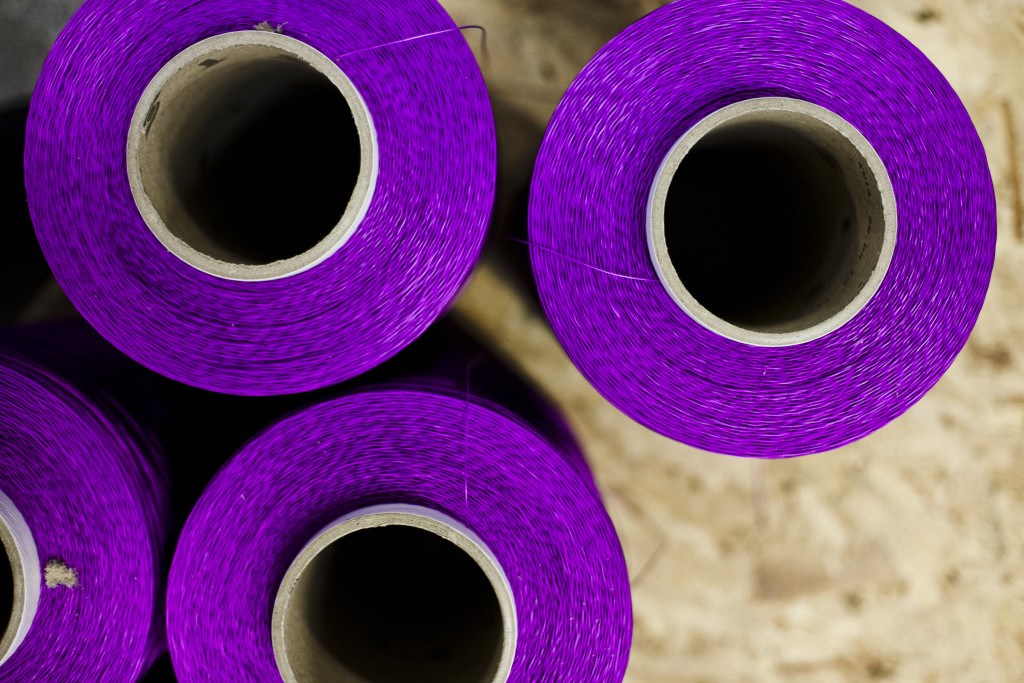 Today the focus is on global expansion and achieving a totally green product. Bolon’s list of clients includes not only Armani but also Google, Mercedes, Adidas, Reebok and Sheraton as well as leading architects and designers. All design and production happens in Ulricehamn, Sweden.
Today the focus is on global expansion and achieving a totally green product. Bolon’s list of clients includes not only Armani but also Google, Mercedes, Adidas, Reebok and Sheraton as well as leading architects and designers. All design and production happens in Ulricehamn, Sweden.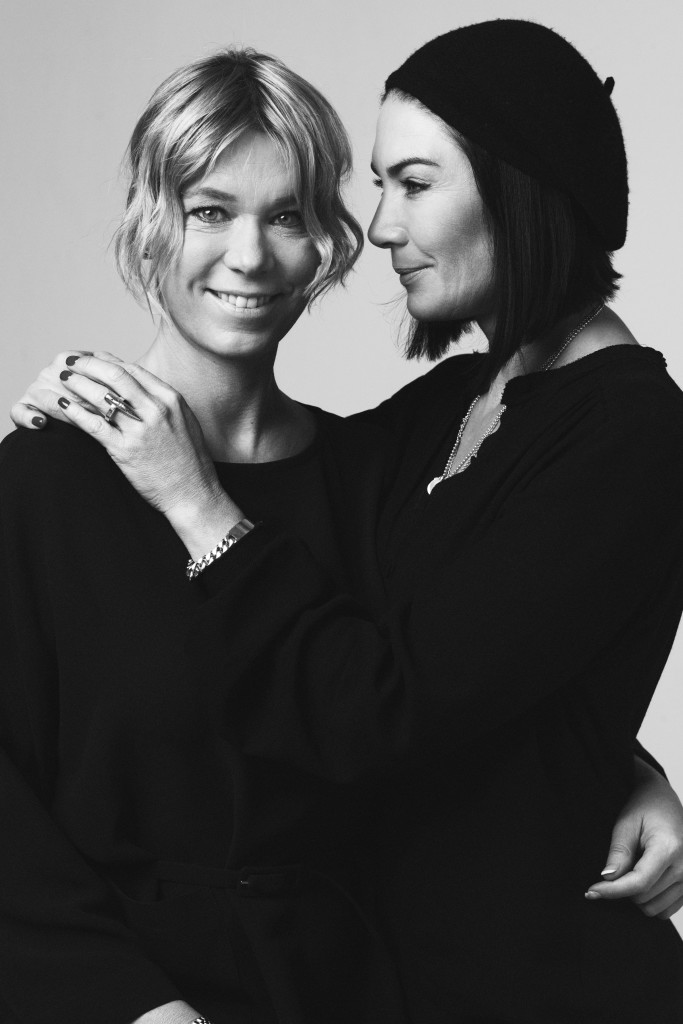 Bolon is available in rolls or tiles. You can vacuum it or for deep cleaning it can be scrubbed with a brush and an all purpose cleaner (there are machines that can do this too). Lastly vacuum again with a wet vac. If you want to delve into the specifics you can do that here. Interesting diversion, yes? Who knows what I'll unearth next! Stay tuned...
Bolon is available in rolls or tiles. You can vacuum it or for deep cleaning it can be scrubbed with a brush and an all purpose cleaner (there are machines that can do this too). Lastly vacuum again with a wet vac. If you want to delve into the specifics you can do that here. Interesting diversion, yes? Who knows what I'll unearth next! Stay tuned...
Museum Inspirations, Italian Style
There are still a couple of amazing experiences I have not shared from my Milan adventure, as a part of the Blanco Design Council earlier this year. One of them was a visit to the Triennale di Milano Design Museum.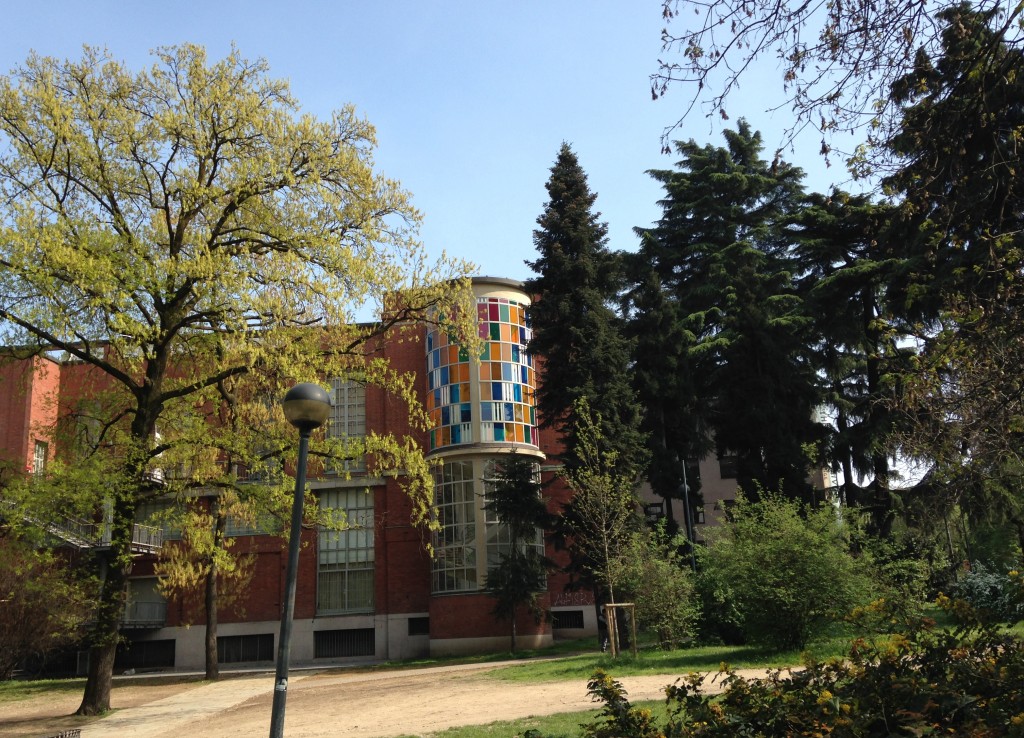 This center for contemporary art, architecture and design focuses on Italy's contribution to all these disciplines. Opened in 2007, rather than being a museum in the classical sense – one with a fixed collection – it is a space with continuously changing exhibitions. The building which houses the Triennale is located at the edge of the Parco Sempione and was built in 1933 by Giovanni Muzio. I discovered it on my first day in Milan whilst strolling in the park trying to shake off the last vestiges of jet lag. Wow!
This center for contemporary art, architecture and design focuses on Italy's contribution to all these disciplines. Opened in 2007, rather than being a museum in the classical sense – one with a fixed collection – it is a space with continuously changing exhibitions. The building which houses the Triennale is located at the edge of the Parco Sempione and was built in 1933 by Giovanni Muzio. I discovered it on my first day in Milan whilst strolling in the park trying to shake off the last vestiges of jet lag. Wow! 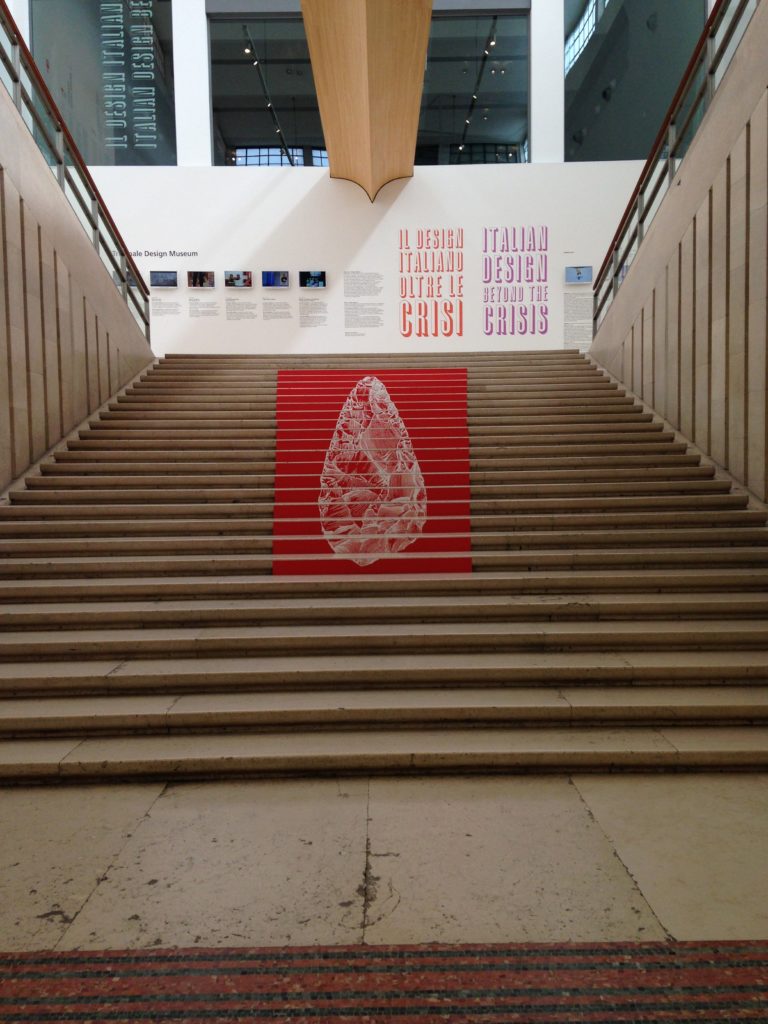
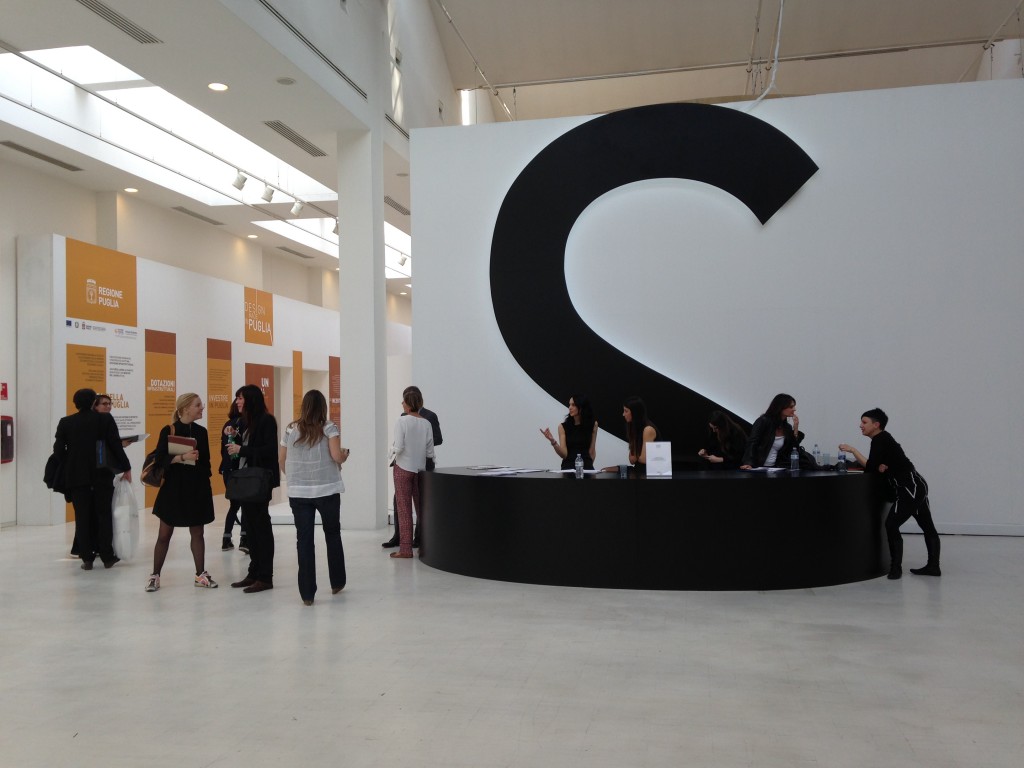
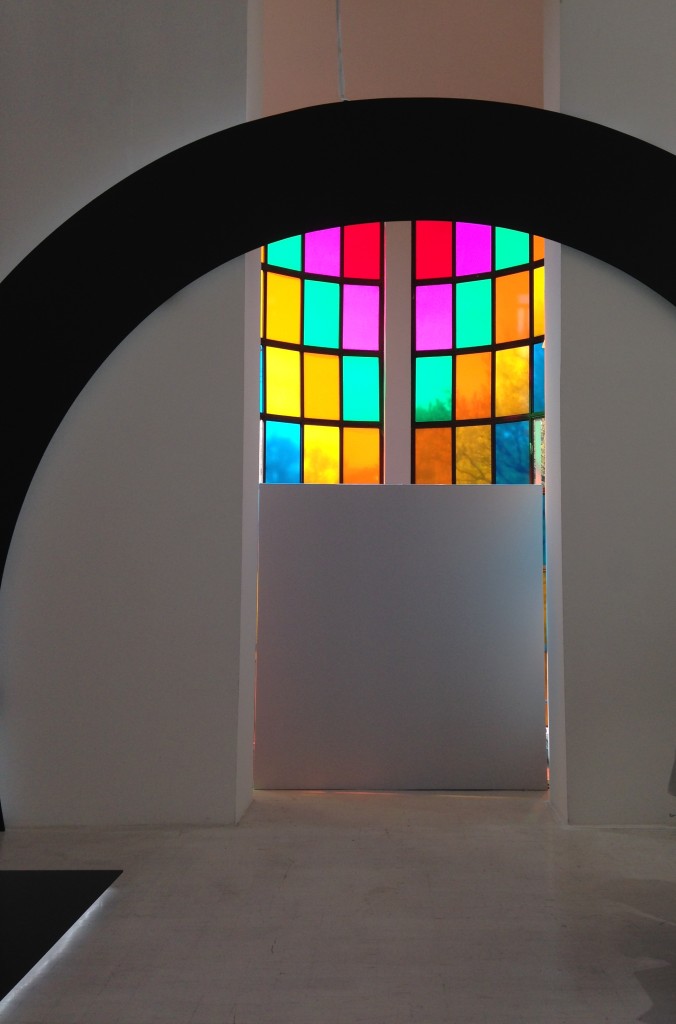 As I found my way to the second floor I discovered an exhibit called Constancy & Change in Korean Traditional Craft 2014. Why Korea you ask? Well Korea and Italy have a long history of diplomatic relations, 130 years.
As I found my way to the second floor I discovered an exhibit called Constancy & Change in Korean Traditional Craft 2014. Why Korea you ask? Well Korea and Italy have a long history of diplomatic relations, 130 years.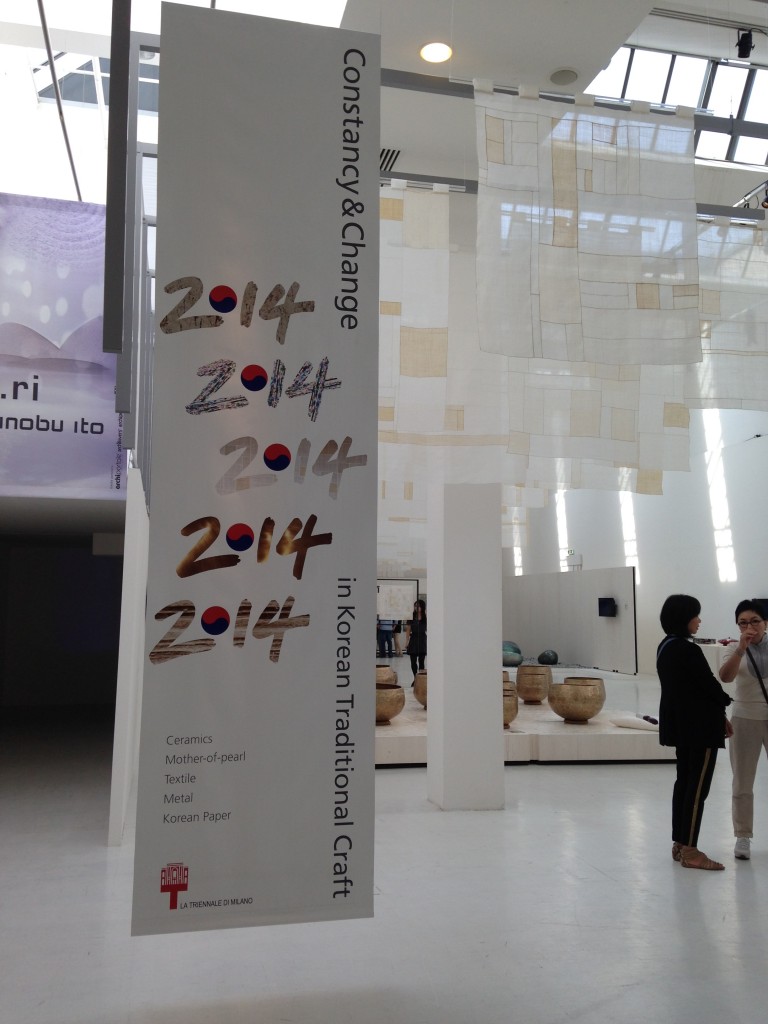 Korean culture has a 5000 year history to draw upon so the exhibit was vast and varied. Curated as a magical journey through time and space, the exhibit consisted of art works by twenty one prominent Korean artists. Although the media was so varied, the common threads were a conscious awareness and incorporation of nature, harmony, simplicity and sophistication.
Korean culture has a 5000 year history to draw upon so the exhibit was vast and varied. Curated as a magical journey through time and space, the exhibit consisted of art works by twenty one prominent Korean artists. Although the media was so varied, the common threads were a conscious awareness and incorporation of nature, harmony, simplicity and sophistication.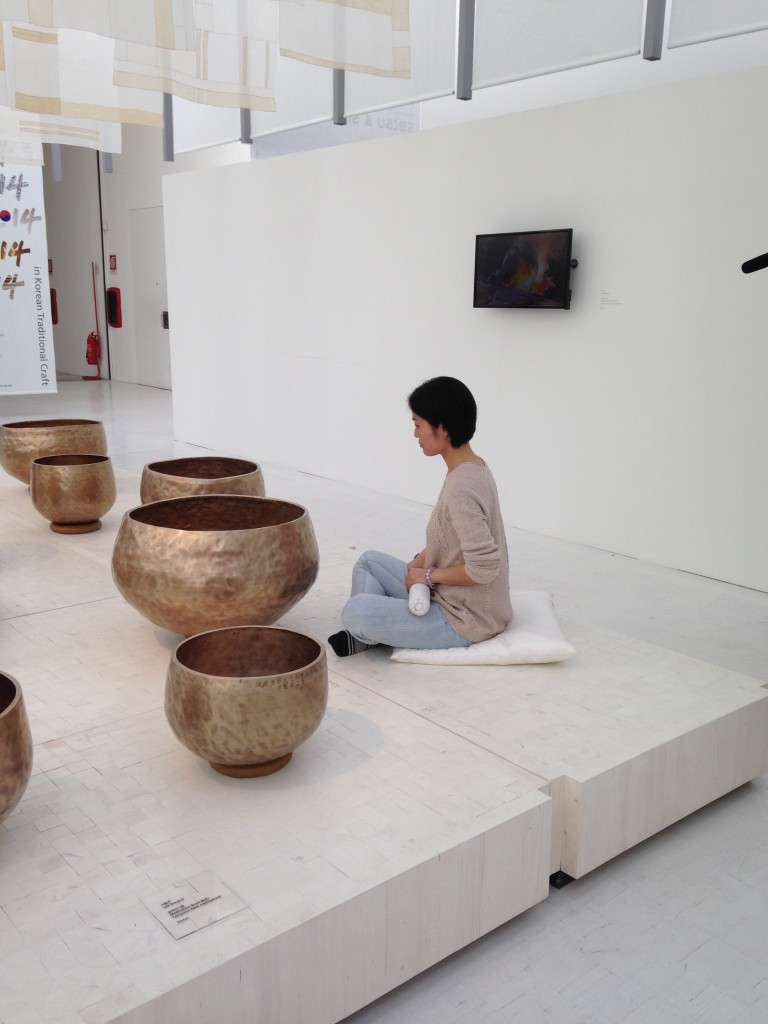 The theme of the exhibit was the five materials of traditional Korean craft: ceramics, hanji (Korean mulberry paper), textiles, metal and lacquer inlaid with mother-of-pearl. Displays were designed to enhance these materials.
The theme of the exhibit was the five materials of traditional Korean craft: ceramics, hanji (Korean mulberry paper), textiles, metal and lacquer inlaid with mother-of-pearl. Displays were designed to enhance these materials.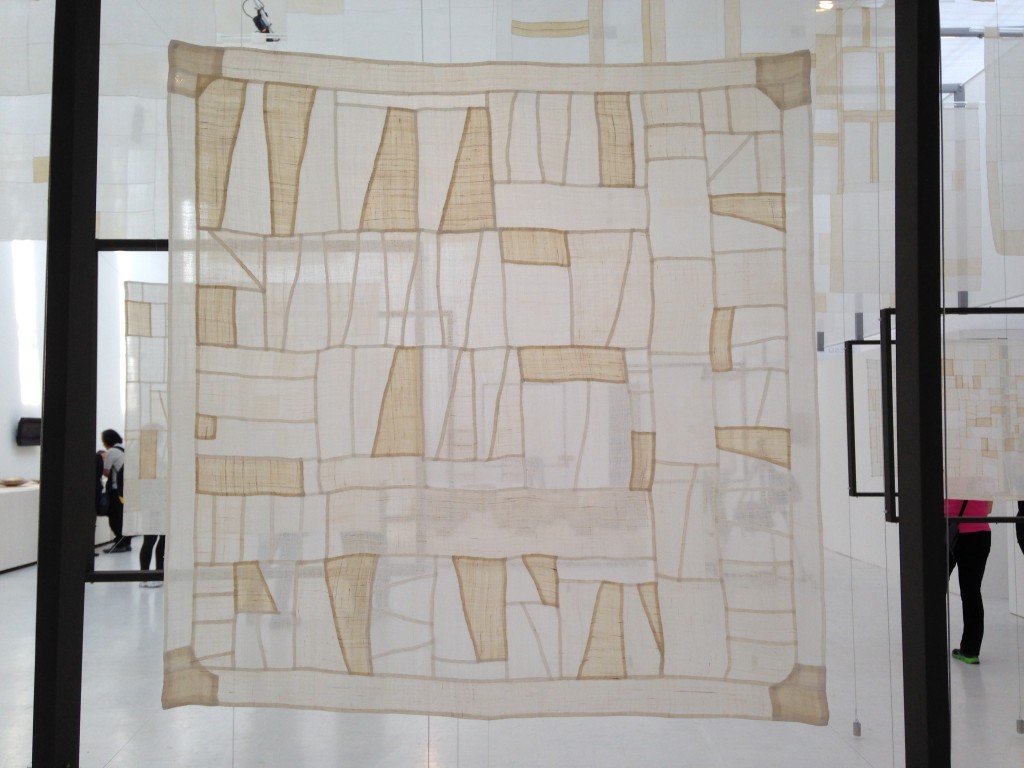 I would be remiss if I didn't mention these stunning cabinets. These are actually book chests made from paulownia and chinaberry woods and hanji (mulberry paper), delicate and sturdy at the same time.
I would be remiss if I didn't mention these stunning cabinets. These are actually book chests made from paulownia and chinaberry woods and hanji (mulberry paper), delicate and sturdy at the same time.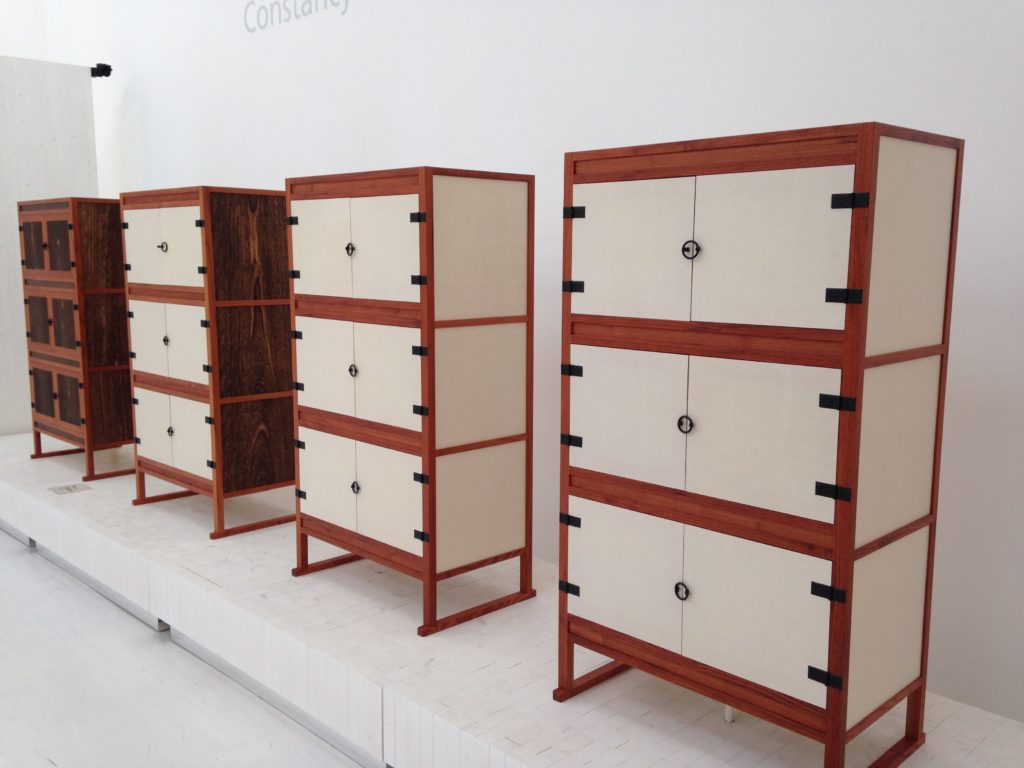 Sometimes the best experiences are of the unplanned variety and that is especially true of this one. I guess the Triennale and I were meant to find each other. ;) More photos from this trip and my other travels visit Kitchens for Living on the Road
Sometimes the best experiences are of the unplanned variety and that is especially true of this one. I guess the Triennale and I were meant to find each other. ;) More photos from this trip and my other travels visit Kitchens for Living on the Road
FTK: Latest in Appliances on Show at EuroCucina
Let’s see. Where were we? Ah, yes. I was going to tell you about FTK at iSaloni. If you don’t know about my trip to Milan with the Blanco Design Council during Design Week, you’ve got some catching up to do! Anyway, FTK, or Technology for the Kitchen, is a showcase for innovation in the category of domestic appliances. 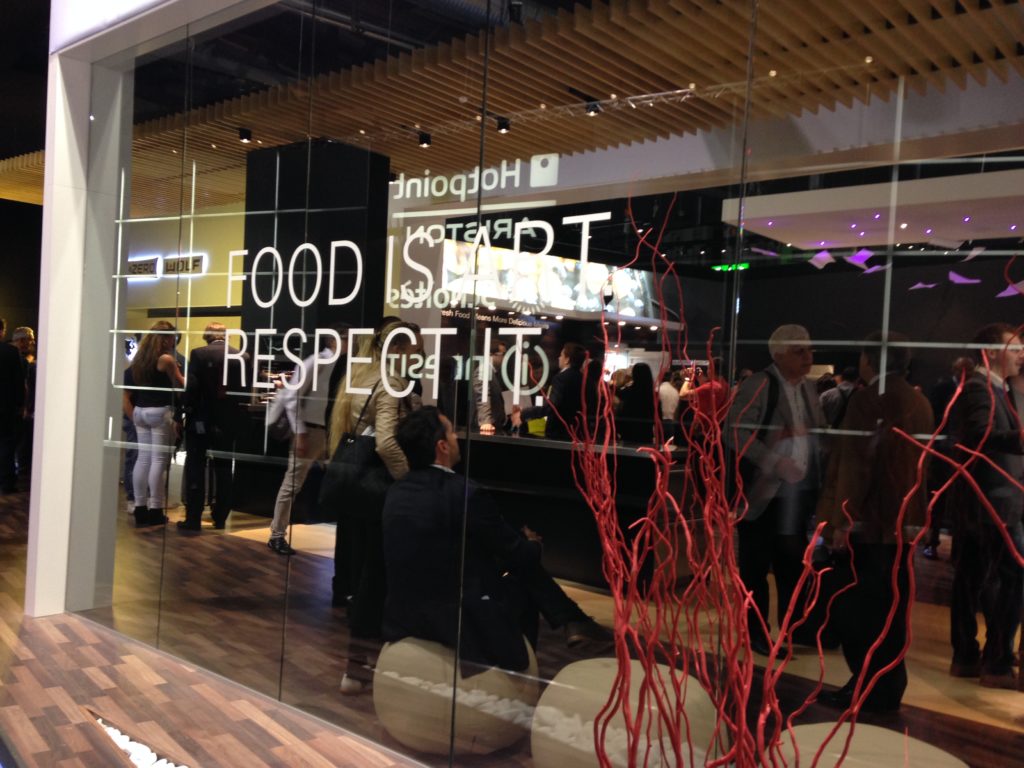 The focus is on the seamless integration of cooking and refrigeration technology in the kitchen. It is a world event so I saw names I am familiar with such as Miele, Electrolux and for the first time at this show, Subzero Wolf (above). I also saw many unfamiliar brands such as Turkey’s Arcelik (Beko) Group which was also making its debut at EuroCucina 2014.
The focus is on the seamless integration of cooking and refrigeration technology in the kitchen. It is a world event so I saw names I am familiar with such as Miele, Electrolux and for the first time at this show, Subzero Wolf (above). I also saw many unfamiliar brands such as Turkey’s Arcelik (Beko) Group which was also making its debut at EuroCucina 2014. 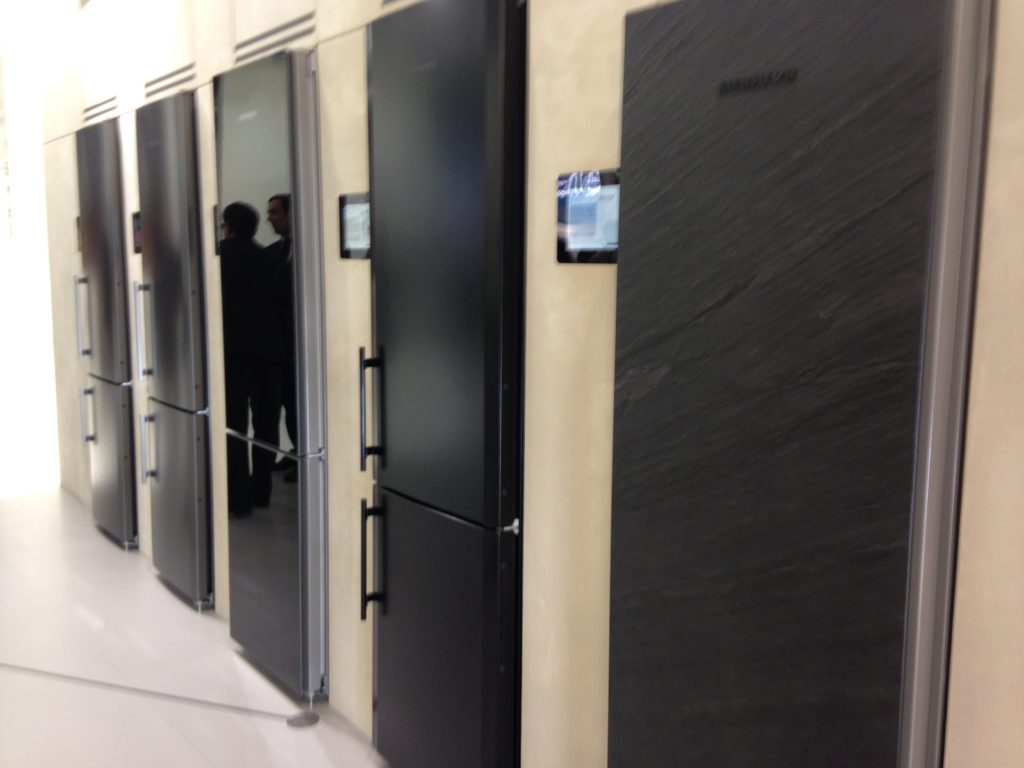 In Europe we Americans have a reputation for embracing BIG! This includes cars, portions and, yes, refrigerators. Did you know what we call a standard refrigerator is referred to as an “American Refrigerator” in Europe? This is a misconception as there are many NYC apartment owners who I'm sure would warmly embrace their kitchen luxury a bit scaled down! Am I right? Compact sizing was a popular offering along with ease of operation and low energy consumption.
In Europe we Americans have a reputation for embracing BIG! This includes cars, portions and, yes, refrigerators. Did you know what we call a standard refrigerator is referred to as an “American Refrigerator” in Europe? This is a misconception as there are many NYC apartment owners who I'm sure would warmly embrace their kitchen luxury a bit scaled down! Am I right? Compact sizing was a popular offering along with ease of operation and low energy consumption. 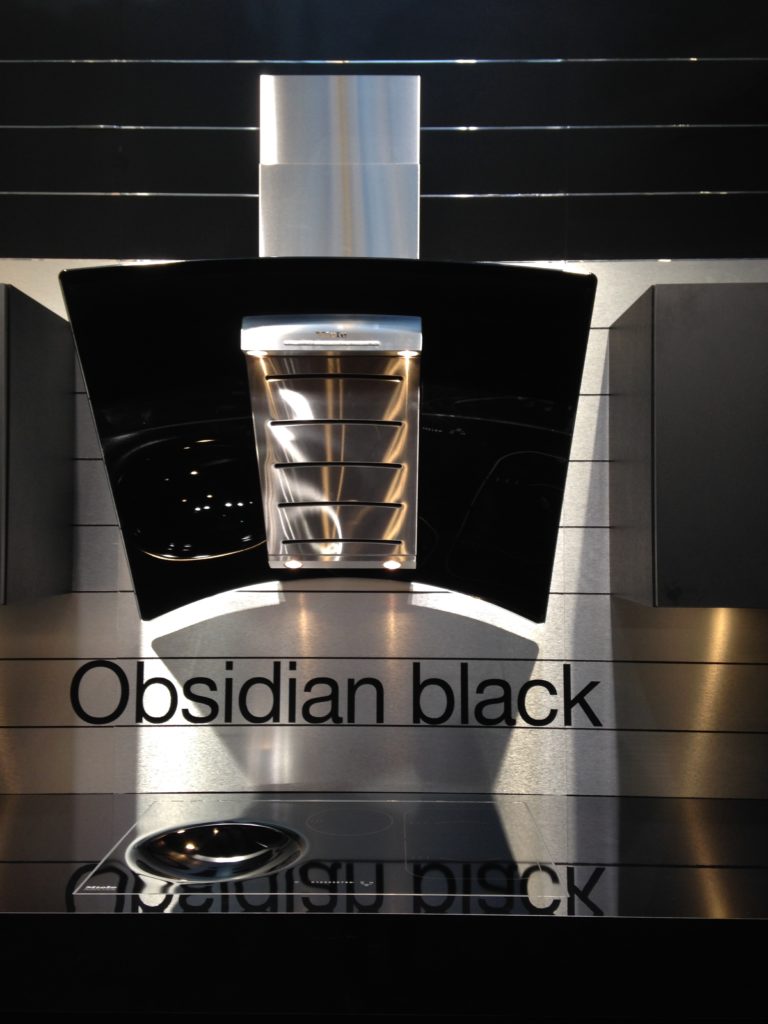 I saw new color choices for appliances such as the return of black and white for high end appliances, as featured at Miele.
I saw new color choices for appliances such as the return of black and white for high end appliances, as featured at Miele.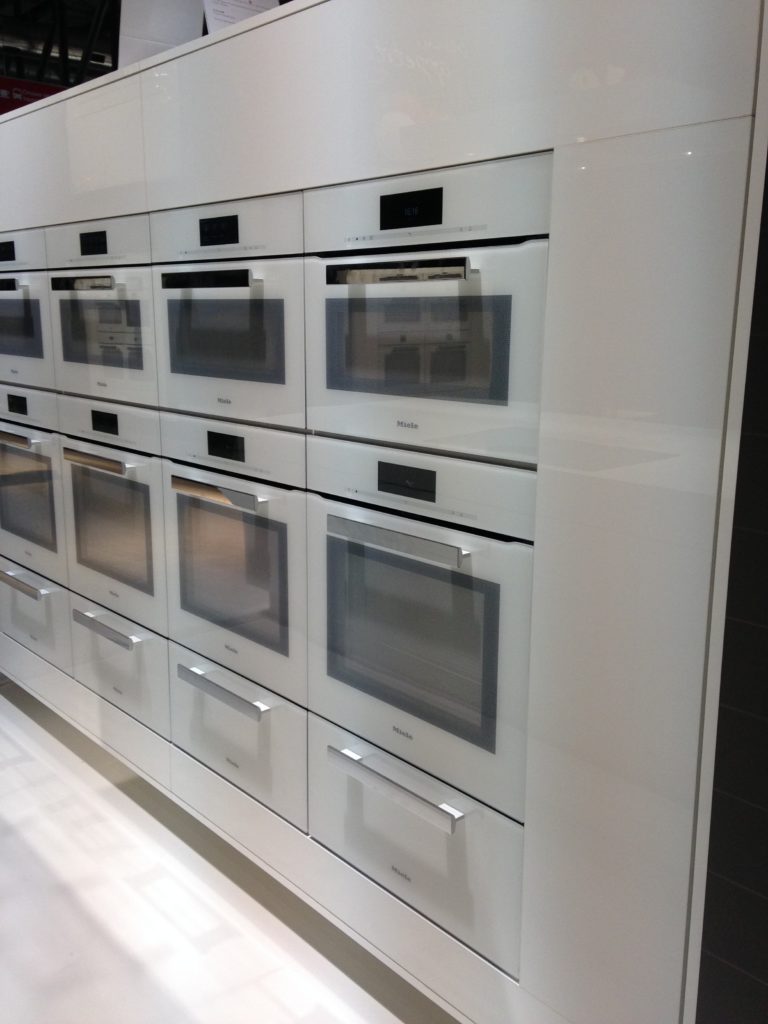 Ventilation was perhaps the “design star” at FTK with all kinds of sculptural sexy hood choices on show. All the appliances were design oriented as well as efficient, offering consumers products that meet technical demands while holding their own in the “looks department”. This means appliances for the home have taken on new shapes, colors and materials in addition to being light, compact, ergonomic and extremely appealing.
Ventilation was perhaps the “design star” at FTK with all kinds of sculptural sexy hood choices on show. All the appliances were design oriented as well as efficient, offering consumers products that meet technical demands while holding their own in the “looks department”. This means appliances for the home have taken on new shapes, colors and materials in addition to being light, compact, ergonomic and extremely appealing. 
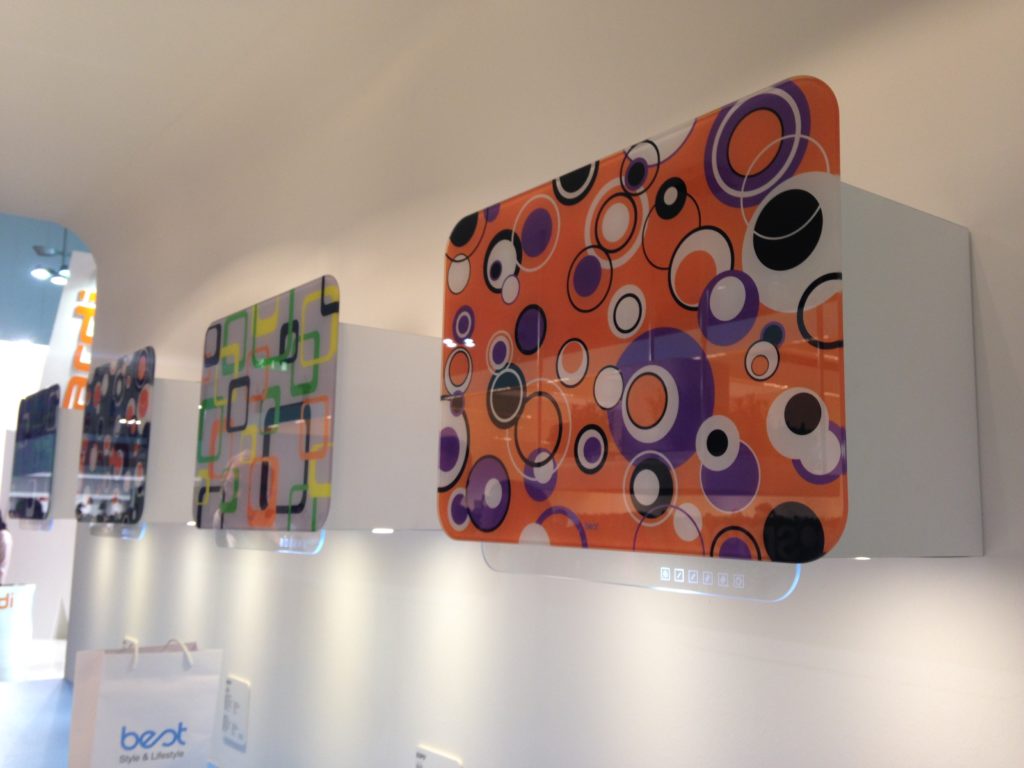 Steam and induction cooking continue to take the industry by force. They’re not going away peeps!
Steam and induction cooking continue to take the industry by force. They’re not going away peeps! 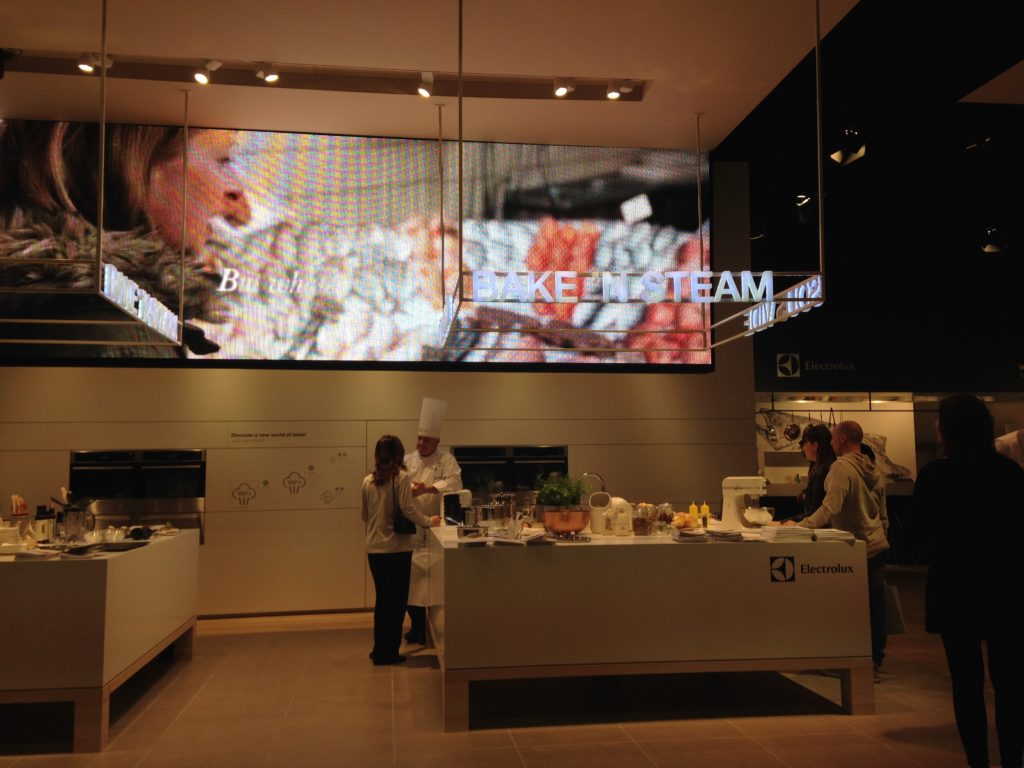 Contemporary lifestyles and increasingly open floor plans require versatile, multi-purpose solutions. In some areas of the globe, not only is fresh water a precious commodity, but so is fresh air. Check out these interesting air purifiers.
Contemporary lifestyles and increasingly open floor plans require versatile, multi-purpose solutions. In some areas of the globe, not only is fresh water a precious commodity, but so is fresh air. Check out these interesting air purifiers. 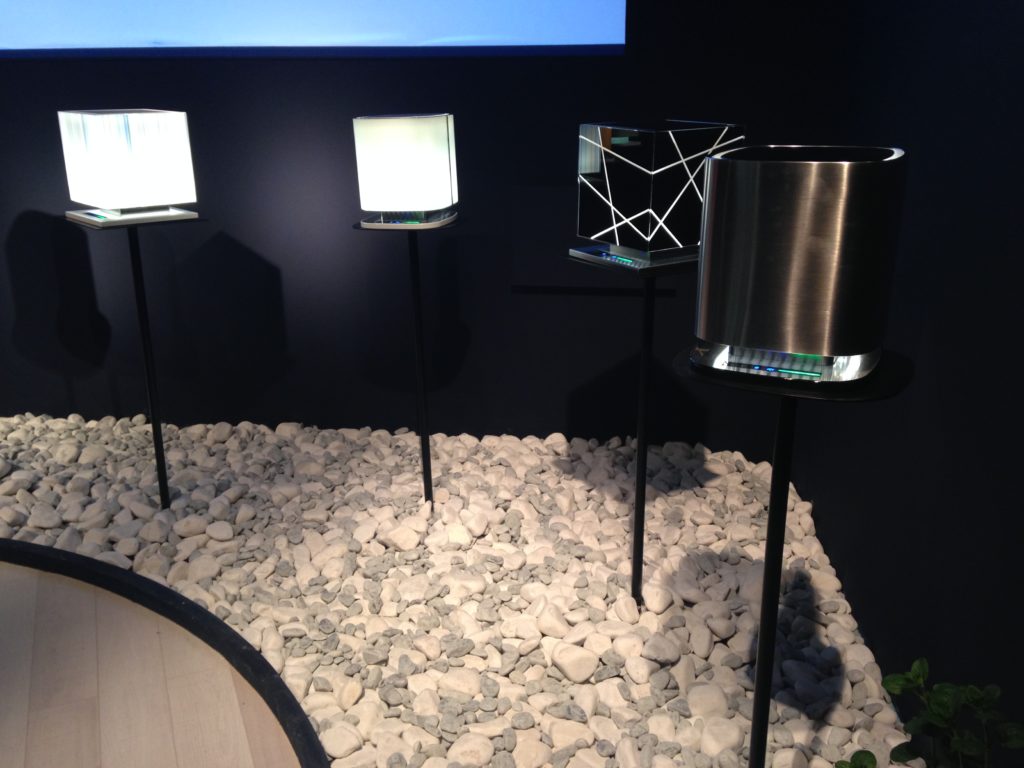 Next up: What's going on in the bathroom? Salone Internazionale del Bagno. If you'd like to see all my photos from Design Week Milan, I've got you covered. Just click here.
Next up: What's going on in the bathroom? Salone Internazionale del Bagno. If you'd like to see all my photos from Design Week Milan, I've got you covered. Just click here.
Kitchen Love, Italian Style at Acheo and Poggenpohl
Ok so you got me, Poggenpohl is not Italian. They are German, except when they're in Milan, then they're Italian. Good enough? I can hardly believe I’ve been home for over a week! Images and impressions are still swirling around in my head from the wonderful time I spent with Blanco and some fellow members of the Blanco Design Council in Milan. Design Week was not limited to the extensive exhibition at the Rho Fairgrounds but also included events all over town. We visited two memorable and cutting edge showrooms on our visit. 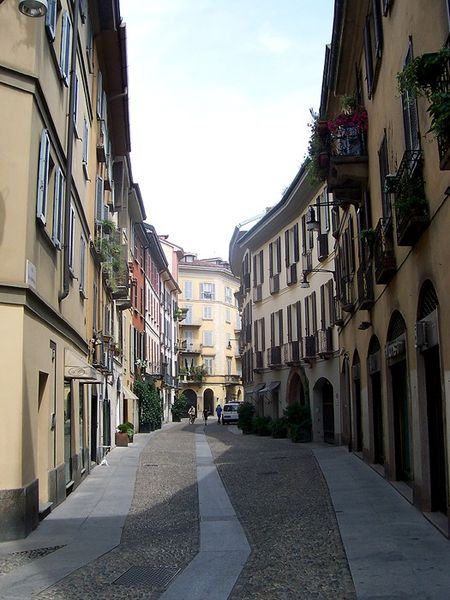 The first was Acheo (pronounced AH-kee-oh), located in the Brera district. Brera is also known today as the design district. It is also one of the few really old areas of Milan which saw 80% destruction during WWII. Acheo opened it’s showroom there in 2010. Today they are a showcase of quintessential contemporary Italian design for the kitchen.
The first was Acheo (pronounced AH-kee-oh), located in the Brera district. Brera is also known today as the design district. It is also one of the few really old areas of Milan which saw 80% destruction during WWII. Acheo opened it’s showroom there in 2010. Today they are a showcase of quintessential contemporary Italian design for the kitchen.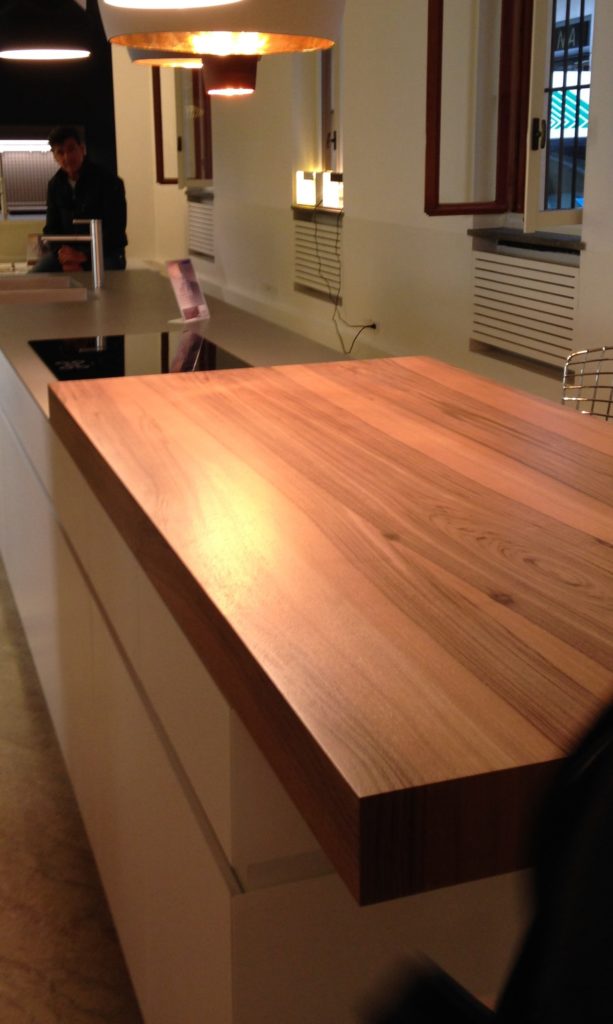 They put on an impressive pre-dinner spread for us and the peeps from Modenus Blogtour Milan.
They put on an impressive pre-dinner spread for us and the peeps from Modenus Blogtour Milan.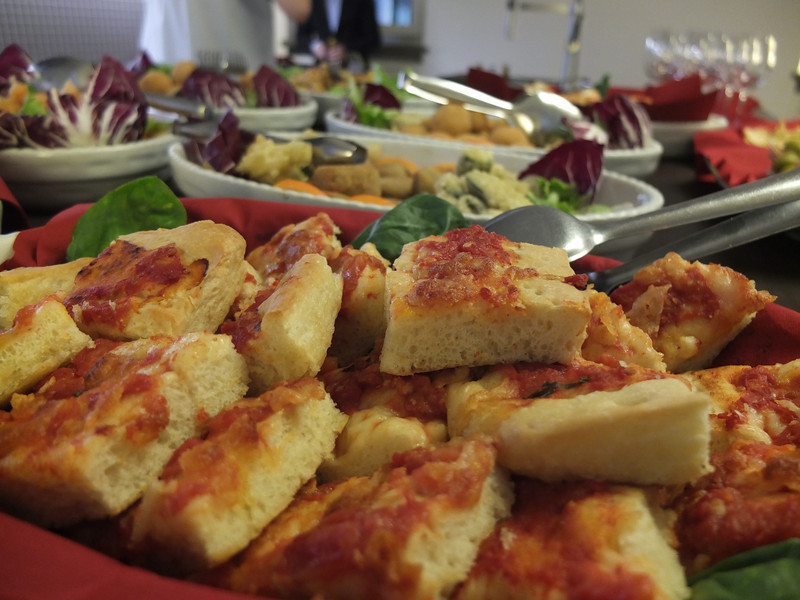 All through our trip we saw many products not available here in the US. Some will become available, perhaps in other versions. One such item is this Durinox work top and sink (below) which is a part of the Blanco Steel Art collection. Think stainless steel on steroids!! Seriously, it is made with a finishing process used in the auto and aerospace industries so it is super scratch resistant and more than twice as hard as stainless steel. It is available, as shown, in Europe from Blanco in Germany. The sinks only will be available for undermount installation here in the US.
All through our trip we saw many products not available here in the US. Some will become available, perhaps in other versions. One such item is this Durinox work top and sink (below) which is a part of the Blanco Steel Art collection. Think stainless steel on steroids!! Seriously, it is made with a finishing process used in the auto and aerospace industries so it is super scratch resistant and more than twice as hard as stainless steel. It is available, as shown, in Europe from Blanco in Germany. The sinks only will be available for undermount installation here in the US. We found that in Milan you could miss half the experience if you failed to look up! Look at these cool light fixtures at Acheo!
We found that in Milan you could miss half the experience if you failed to look up! Look at these cool light fixtures at Acheo!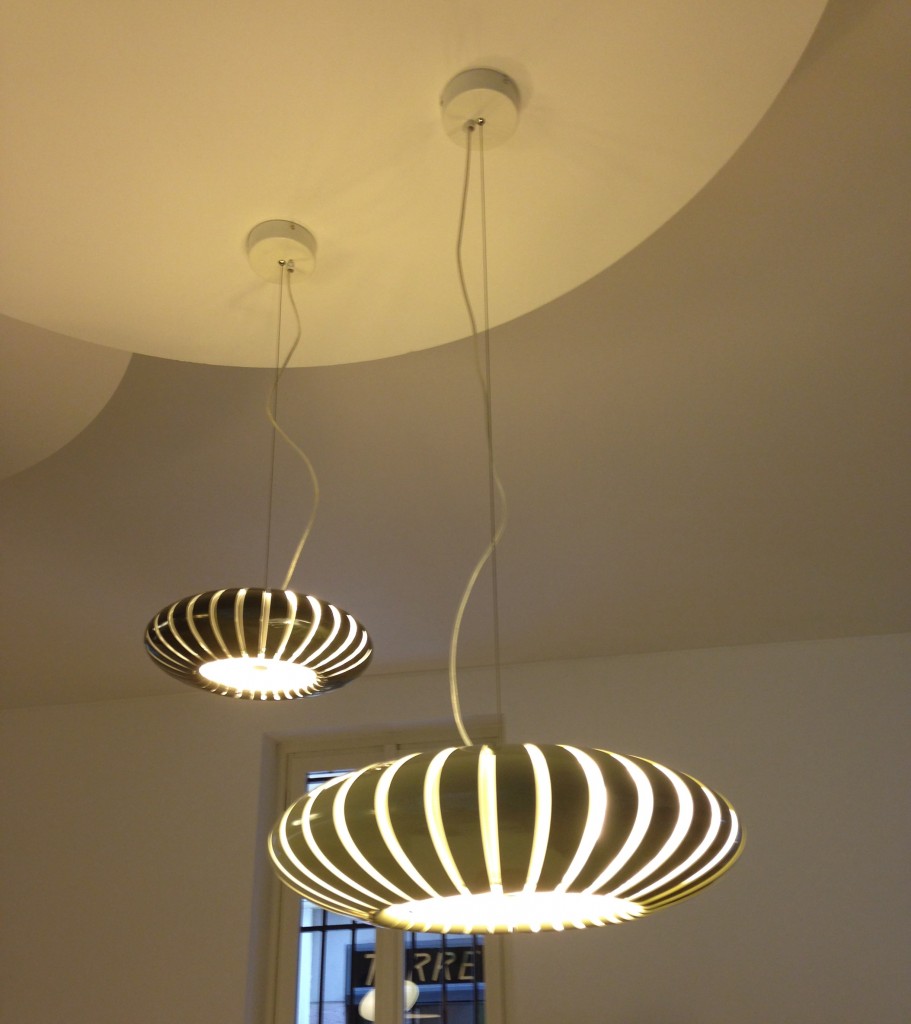 The other showroom we had the pleasure of visiting during our visit was Poggenpohl. I think you could argue that they set the bar when it comes to innovation in contemporary cabinet design. As I mentioned, Poggenpohl is a German company and they claim to be the oldest kitchen brand in the world!
The other showroom we had the pleasure of visiting during our visit was Poggenpohl. I think you could argue that they set the bar when it comes to innovation in contemporary cabinet design. As I mentioned, Poggenpohl is a German company and they claim to be the oldest kitchen brand in the world! 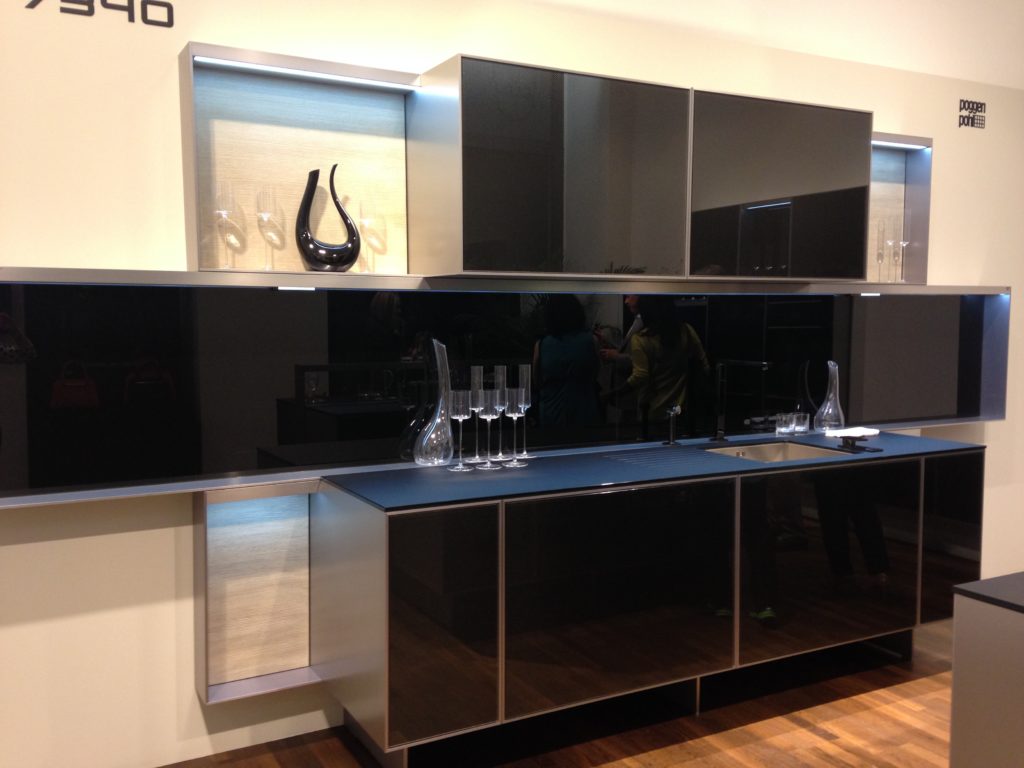 Some years ago Poggenpohl teamed up with the Porsche Design Studio to develop the P'7340 line of cabinets. Both companies focus their concentration on the overall line as well as providing unsurpassed quality of product. Above is a Porsche Design Kitchen P'7340 by Poggenpohl. It's hallmark is the aluminum frame which surrounds each box. Originally designed with men in mind, it has evolved into a brand appealing to discerning contemporary design devotees of either sex. Chief Poggenpohl designer Manfred Junker was on hand to explain the intricacies of design detail that go into the product including their trademark, no handle, fronts. In fact, he claims, they are the first to offer touch control on the refrigerator and dishwasher. Here's what they have to say about that on their website: "Handleless fronts emphasize the clean, uncompromised lines of the kitchen furniture."
Some years ago Poggenpohl teamed up with the Porsche Design Studio to develop the P'7340 line of cabinets. Both companies focus their concentration on the overall line as well as providing unsurpassed quality of product. Above is a Porsche Design Kitchen P'7340 by Poggenpohl. It's hallmark is the aluminum frame which surrounds each box. Originally designed with men in mind, it has evolved into a brand appealing to discerning contemporary design devotees of either sex. Chief Poggenpohl designer Manfred Junker was on hand to explain the intricacies of design detail that go into the product including their trademark, no handle, fronts. In fact, he claims, they are the first to offer touch control on the refrigerator and dishwasher. Here's what they have to say about that on their website: "Handleless fronts emphasize the clean, uncompromised lines of the kitchen furniture."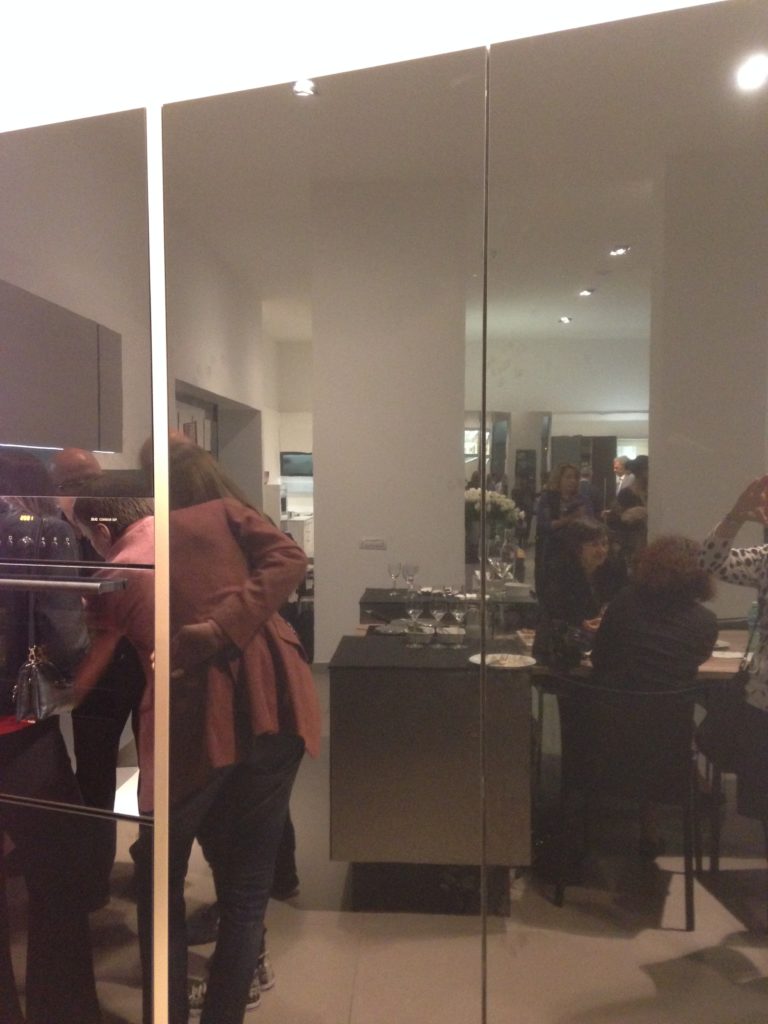 Poggenpohl took care of our tummies too. After all, design spotting can work up one hell of an appetite!
Poggenpohl took care of our tummies too. After all, design spotting can work up one hell of an appetite!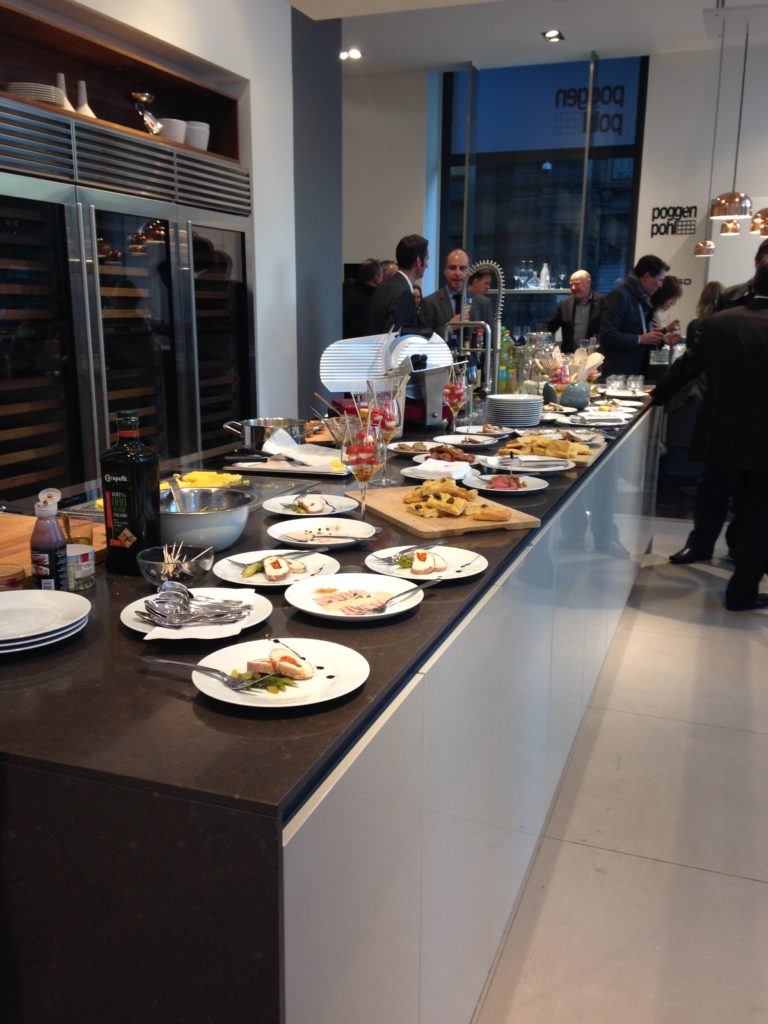 This newest version of P'7340 (see below) features a contrasting counter top inset made of solid New Zealand pine with a wire brushed finish.
This newest version of P'7340 (see below) features a contrasting counter top inset made of solid New Zealand pine with a wire brushed finish.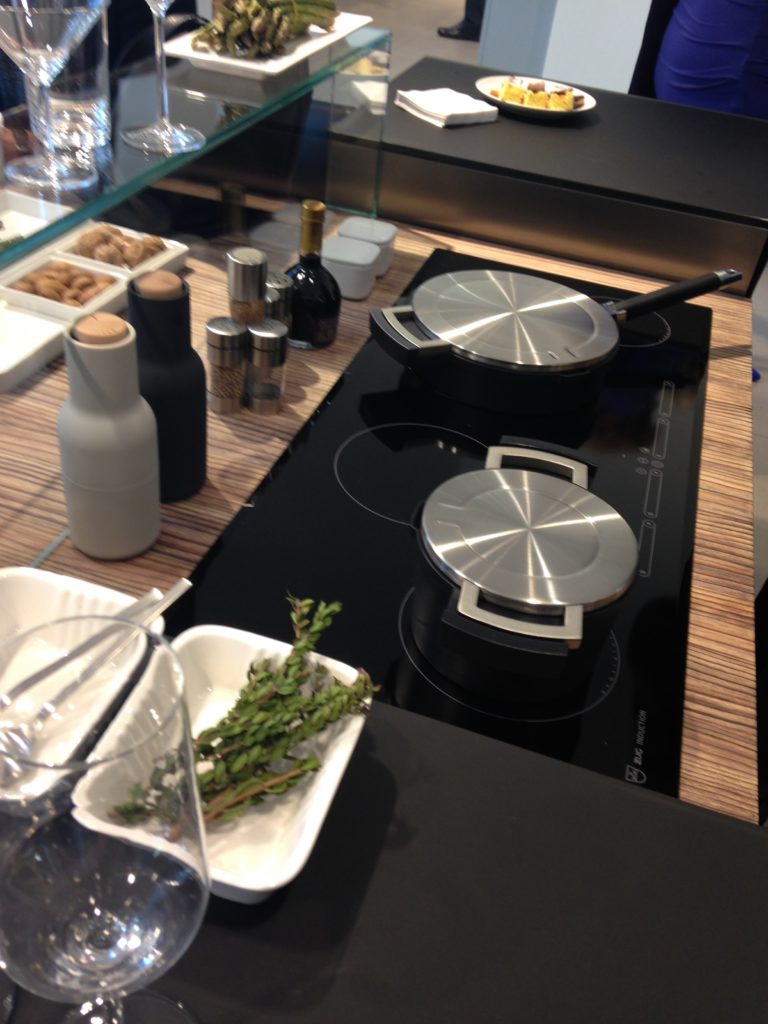 Next up: FTK (Technology for the Kitchen) This was the section of iSaloni featuring the latest trends and products in kitchen appliances.Click here for a peek at all my Milan photos!own and automatically completes the closing cycle
Next up: FTK (Technology for the Kitchen) This was the section of iSaloni featuring the latest trends and products in kitchen appliances.Click here for a peek at all my Milan photos!own and automatically completes the closing cycle
Euro Cucina 2014
I'm home and just about recovered from my jet lag. All pics are up for your perusal. It was a fabulous trip and my heartfelt gratitude goes out to the golden peeps at Blanco, including travel mate Christy Emens as well as Lori Dolnick of Frank Advertising. I was honored to be included with fellow bloggers Marilyn Russell (DesignMagnifique), Kelly Morisseau (KellyMorisseau.com) and Grace & Ken Kelly of (kitchendesigns.com). Having been to many trade shows in the US over the years, I've always wanted to experience the bigger, global picture. Now I have and it was amazing.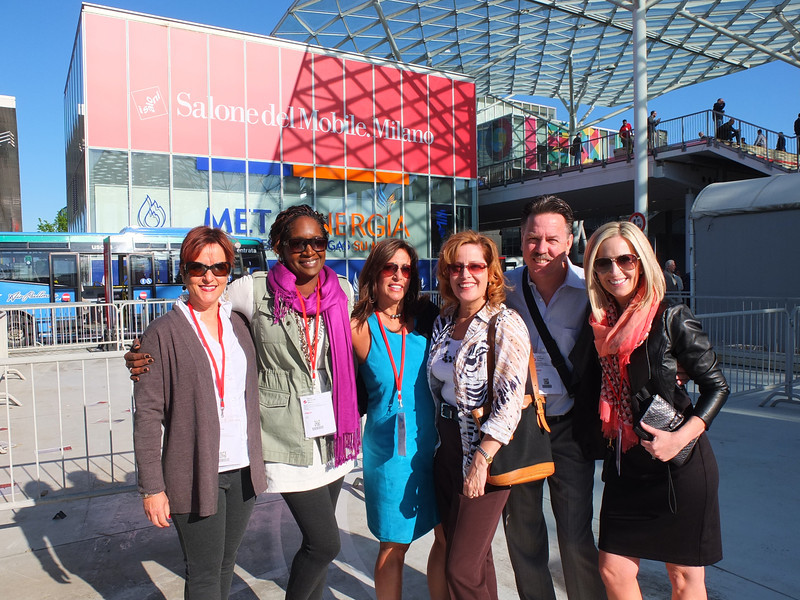 I arrived on Monday morning ready to explore. Lori and I took a stroll and stumbled upon a delicious lunch and a very cool design museum but first things first. I'm dying to tell you about all the products and trends I saw at the big show. Euro Cucina only comes along every two years as a part of the Salone del Mobile. Milano. There is also a whole section devoted to the bath called Salone Internazionale del Bagno. Kitchen gadgets and appliances are shown in the FTK section. I did a pretty good job of covering those but I estimate that was only about 20% of the entire show, the rest being furniture and other aspects of design. Here's what caught my eye.
I arrived on Monday morning ready to explore. Lori and I took a stroll and stumbled upon a delicious lunch and a very cool design museum but first things first. I'm dying to tell you about all the products and trends I saw at the big show. Euro Cucina only comes along every two years as a part of the Salone del Mobile. Milano. There is also a whole section devoted to the bath called Salone Internazionale del Bagno. Kitchen gadgets and appliances are shown in the FTK section. I did a pretty good job of covering those but I estimate that was only about 20% of the entire show, the rest being furniture and other aspects of design. Here's what caught my eye.
Counter tops were either very thin or chunky, like 1/2" for the thin and 3" for the chunky. I saw a lot of mixing of materials, in fact, that was probably the one biggest trend I saw for both counter tops and cabinets. It is also one that can easily be adapted to our US market. Counter top materials are much more adventurous than the usual granite or quartz that we are used to here. I saw wood, Corian, recycled composite material and more. The overlapping installation here was also quite common. The kitchen sink saw some new innovations including lots of accessories and different methods of installation. The inset style above, by Blanco, is factory installed by Leicht for a perfect fit. This particular one is not available to us in the US but we can get the Precision model with the distinctive square corner interior for undermount applications.
The kitchen sink saw some new innovations including lots of accessories and different methods of installation. The inset style above, by Blanco, is factory installed by Leicht for a perfect fit. This particular one is not available to us in the US but we can get the Precision model with the distinctive square corner interior for undermount applications. 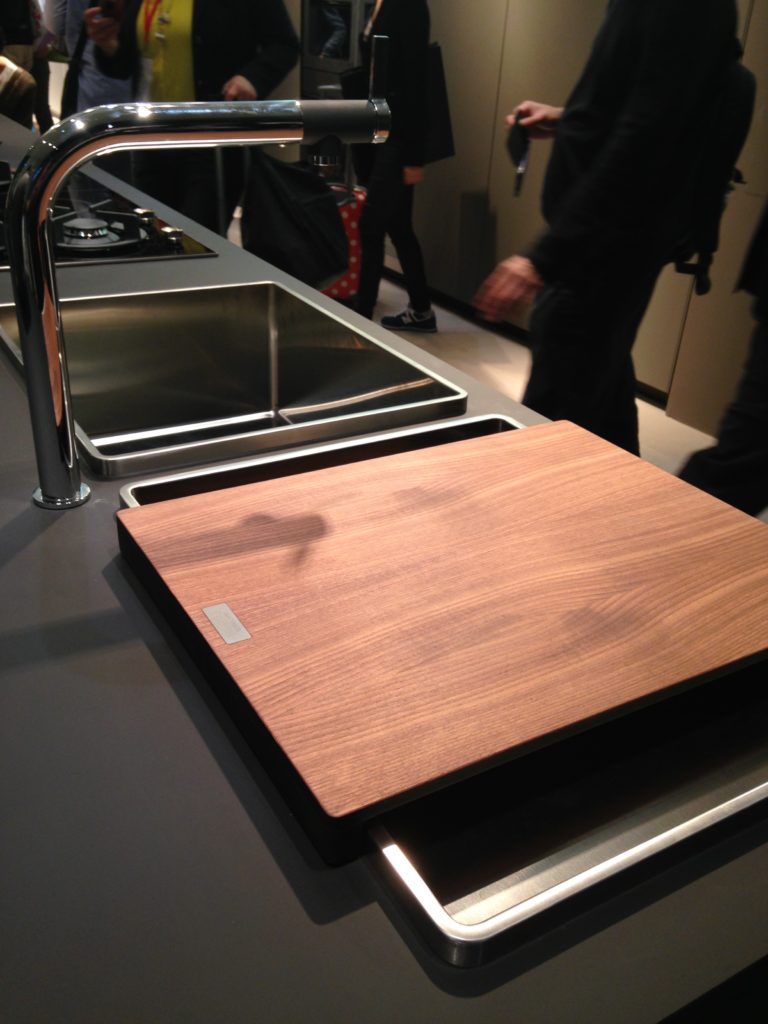
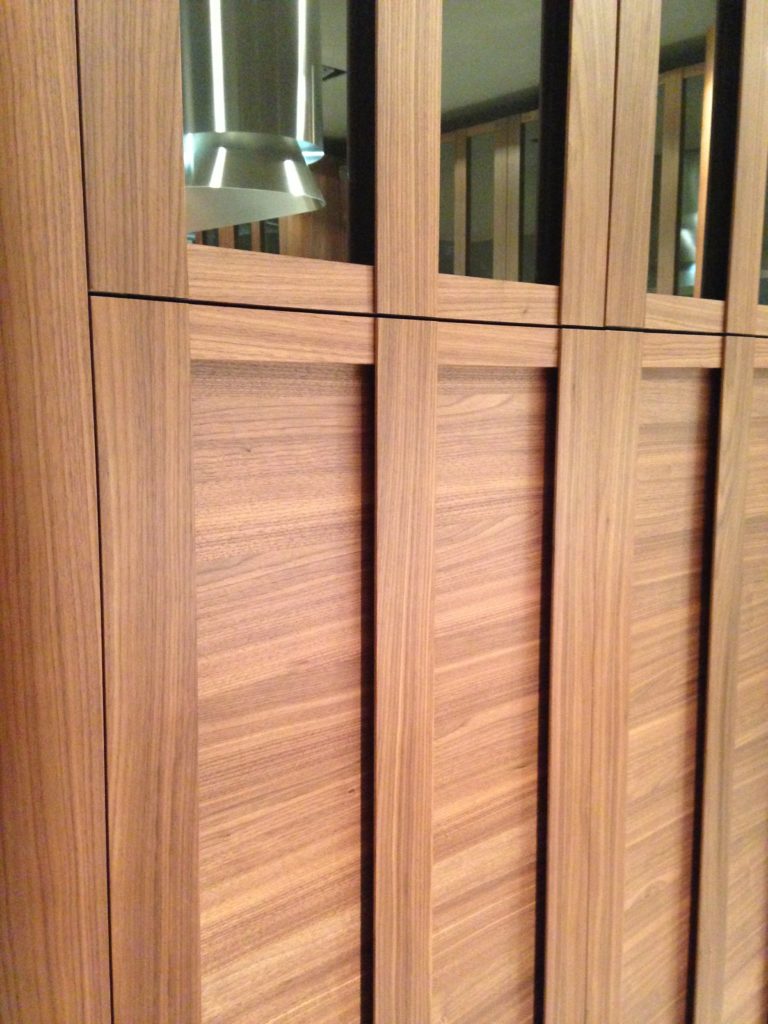 Cabinets featured lots of defined graining in woods such as white oak, rosewood and walnut in both horizontal and vertical directions, sometimes on the same door. I also saw some interesting variations on the popular slab and Shaker silhouettes.
Cabinets featured lots of defined graining in woods such as white oak, rosewood and walnut in both horizontal and vertical directions, sometimes on the same door. I also saw some interesting variations on the popular slab and Shaker silhouettes.
 This is just the first in a series of posts about Milan and Salone Internazionale del Mobile. Upcoming posts will include our visits to Acheo and Poggenpohl showrooms and much more. So what do you think of these kitchen trends so far? I think some will make it over the pond but you can always know that whatever we do, we'll do it with an Americano twist. More later :)Click here for a peek at all my Milan photos!
This is just the first in a series of posts about Milan and Salone Internazionale del Mobile. Upcoming posts will include our visits to Acheo and Poggenpohl showrooms and much more. So what do you think of these kitchen trends so far? I think some will make it over the pond but you can always know that whatever we do, we'll do it with an Americano twist. More later :)Click here for a peek at all my Milan photos!
